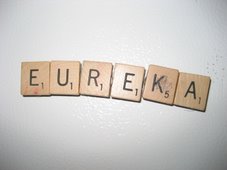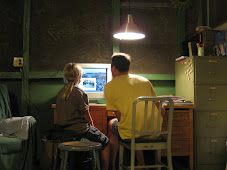We recently had a flurry of activity involving the kids running around the house singing "Kill the wabbit, kill the wabbit, ..." over and over. We don't have cable TV, and we don't watch cartoons much, so, oddly enough, they were singing to the tune of Clementine. Now it is perfectly ok if they have never heard of the Constitution or what it means, but Bugs Bunny is an important part of our cultural heritage. One does not sing Kill the Wabbit to Clementine. I had to act to correct this behavior before it was too late. This inspired an internet trip that made a number of unexpected connections.
We started with a visit to Youtube to view the original copyright infringed version of "What's Opera, Doc?" the source of the Kill the Wabbit song performed to the most famous tune from Wagner's Ring. We then found a site with clips from the opera itself and found and listened to the piece in question, the melody from The Ride of the Valkyries. Having established that some guy named Wagner wrote the music, we tried to find out more about him. That's when we started making connections.
Our next stop was at Wikipedia where we learned about Wagner and his famed opera: up to five hours with no intermission, he invented instruments to expand the orchestra, and his struggles to build an opera house suitable for this work. In reading about the story, we discovered our first connection. We are reading The Lord of the Rings, and we found out that Wagner's Der Ring des Nibelungen is derived from some of the same mythology as The Lord of the Rings and has some similarities to the Tolkien story.
Our next connection came when we read about the music. Wagner relied heavily on the use of leitmotifs to guide the listener through the story. Leitmotifs are musical themes that correspond to themes, events, or characters in the story. Our oh-so-close-to-home examples are the themes used by John Williams in the music to Star Wars. We have the movies and soundtrack, and now Sam is learning the Imperial March (Darth Vader's theme) on the piano. I don't know if she'll be any more proud knowing it's a leitmotif.
Our final connection relates to our study of World War II, antisemitism and Adolf Hitler. It appears the extent of Wagner's antisemitism is debatable, but his writings and music were interpreted as supporting the views of the Nazis and Hitler, and Hitler promoted Wagner's music as supporting the Aryan ideal. Yuck. How about we leave the wabbit be?
I think that these kinds of connections are what make learning stick. We can spend an hour and a half researching on the internet including videos and music and get so much. Sure beats film strips.
skip to main |
skip to sidebar


Where will their adventures take them?

We moved to www.eurekafamily.blogspot.com in June 2011

TinTin and Snowy

Where will their adventures take them?

About Us
- C =Boy, aged 13, K=Girl (AKA Kit), aged 11, Mom & Dad
- We are a couple of kids in the southern Sierra Foothills. We (used to) homeschool and like to travel and do other stuff kids like to do. We also like to ride bikes. We named our Blog "Eureka!" because that's what Tintin says when he discovers something, and its the slogan for our state, California. (And, Mom made us do it.)
Our Pets
- Acrobat (chicken)
- Bertha (chicken) (RIP)
- Cedar (chick)
- Chessie the superkitten! aka Fuzzo or Baby Bookins
- Chipper (chick) (RIP)
- Glay (chickenRIP)
- Lulu (dog who thinks she's a cat)
- Pecker & Blackie (twin chickens)
- Poppy (chicken)
- Pumpkin (chicken)
- Rodher (Chicken)
- Sneezer (chick) (RIP)
- Toeser (scaredy cat)
- Weechee (ladybug) (probably dead)
- Whiner RIP (cat who thought she was a dog)
- Witchking (chick) (RIP)
Favorite Movies
- Strange Brew
- Harry Potter Series (both of us)
- Star Wars Series (C)
- Strange Brew
- Lord of the Rings
Favorite Books
- Ranger's Apprenticee
- Percy Jackson
- Sammy Keyes
- The Floating Island
- Hitchhiker's Guide to the Galaxy
- Captain Bluebear
- Lord of the RIngs
- Harry Potter Series